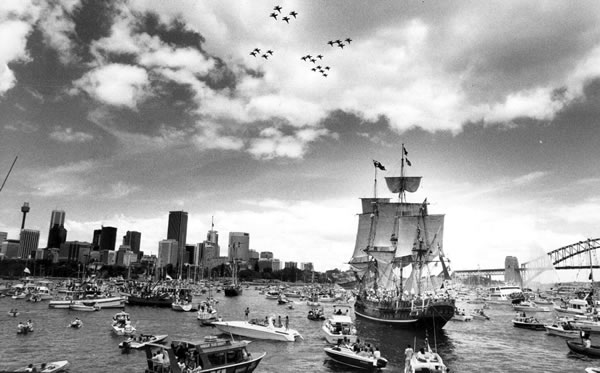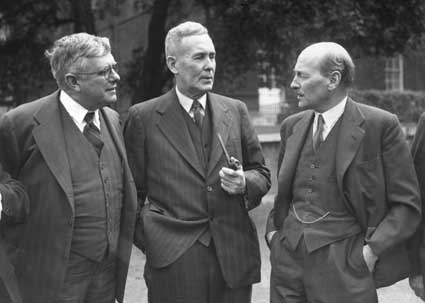|
Bicentenary Of James Cook In Australia
The Bicentenary of James Cook in Australia was commemorated in Australia in 1970. The British explorer Lieutenant (later Captain) James Cook charted the east coast of Australia in 1770, and claimed the eastern seaboard of the continent for the British Crown. It was not considered the official bicentenary of Australia, but rather the bicentenary of the first mapping of the eastern coastline. Commemorations were held throughout Australia in 1970. A commemorative 50 cent coin was issued. A re-enactment of Cook's landing at Botany Bay was held on 29 April 1970. The re-enactment was disrupted by university students, one of whom was dressed as James Cook, arriving at the point on speedboat. The name of the place on the east coast which Cook is believed to have first sighted was renamed from Cape Everard to Point Hicks, the name Cook had given it. Protest Indigenous Australian leaders declared 29 April a "Day of Mourning", and an overnight protest vigil was held at the Botany Bay re ... [...More Info...] [...Related Items...] OR: [Wikipedia] [Google] [Baidu] |
Australia
Australia, officially the Commonwealth of Australia, is a Sovereign state, sovereign country comprising the mainland of the Australia (continent), Australian continent, the island of Tasmania, and numerous List of islands of Australia, smaller islands. With an area of , Australia is the largest country by area in Oceania and the world's List of countries and dependencies by area, sixth-largest country. Australia is the oldest, flattest, and driest inhabited continent, with the least fertile soils. It is a Megadiverse countries, megadiverse country, and its size gives it a wide variety of landscapes and climates, with Deserts of Australia, deserts in the centre, tropical Forests of Australia, rainforests in the north-east, and List of mountains in Australia, mountain ranges in the south-east. The ancestors of Aboriginal Australians began arriving from south east Asia approximately Early human migrations#Nearby Oceania, 65,000 years ago, during the Last Glacial Period, last i ... [...More Info...] [...Related Items...] OR: [Wikipedia] [Google] [Baidu] |
James Cook
James Cook (7 November 1728 Old Style date: 27 October – 14 February 1779) was a British explorer, navigator, cartographer, and captain in the British Royal Navy, famous for his three voyages between 1768 and 1779 in the Pacific Ocean and to New Zealand and Australia in particular. He made detailed maps of Newfoundland prior to making three voyages to the Pacific, during which he achieved the first recorded European contact with the eastern coastline of Australia and the Hawaiian Islands, and the first recorded circumnavigation of New Zealand. Cook joined the British merchant navy as a teenager and joined the Royal Navy in 1755. He saw action in the Seven Years' War and subsequently surveyed and mapped much of the entrance to the St. Lawrence River during the siege of Quebec, which brought him to the attention of the Admiralty and the Royal Society. This acclaim came at a crucial moment for the direction of British overseas exploration, and it led to his commission in ... [...More Info...] [...Related Items...] OR: [Wikipedia] [Google] [Baidu] |
Botany Bay
Botany Bay (Dharawal: ''Kamay''), an open oceanic embayment, is located in Sydney, New South Wales, Australia, south of the Sydney central business district. Its source is the confluence of the Georges River at Taren Point and the Cooks River at Kyeemagh, which flows to the east before meeting its mouth at the Tasman Sea, midpoint between the suburbs of La Perouse and Kurnell. The northern headland of the entrance to the bay from the Tasman Sea is Cape Banks and, on the southern side, the outer headland is Cape Solander and the inner headland is Sutherland Point. The total catchment area of the bay is approximately . Despite its relative shallowness, the bay now serves as greater metropolitan Sydney's main cargo seaport, located at Port Botany, with facilities managed by Sydney Ports Corporation. Two runways of Sydney Airport extend into the bay, as do some port facilities. Botany Bay National Park is located on the northern and southern headlands of the bay. ... [...More Info...] [...Related Items...] OR: [Wikipedia] [Google] [Baidu] |
Point Hicks
Point Hicks (formerly called Cape Everard), is a coastal headland in the East Gippsland region of Victoria, Australia, located within the Croajingolong National Park. The point is marked by the Point Hicks Lighthouse that faces the Tasman Sea. The traditional custodians of the land surrounding Point Hicks are the Australian Aboriginal Bidawal and Gunaikurnai peoples who called the point ''Tolywiarar''. In April 1770 this area became the first land on the east coast of Australia known to have been sighted by Europeans, when reached the continent during the first voyage of James Cook to the Pacific. Name The point is named after Lieutenant Zachary Hicks of the Endeavour who, in April 1770, first saw land presumed to be the east coast of New Holland. History After charting New Zealand during his first voyage of discovery, Cook set a course westwards, intending to strike for Van Diemen's Land (present-day Tasmania) to establish whether or not it formed part of the presumed so ... [...More Info...] [...Related Items...] OR: [Wikipedia] [Google] [Baidu] |
Indigenous Australians
Indigenous Australians or Australian First Nations are people with familial heritage from, and membership in, the ethnic groups that lived in Australia before British colonisation. They consist of two distinct groups: the Aboriginal peoples of the Australian mainland and Tasmania, and the Torres Strait Islander peoples from the seas between Queensland and Papua New Guinea. The term Aboriginal and Torres Strait Islander peoples or the person's specific cultural group, is often preferred, though the terms First Nations of Australia, First Peoples of Australia and First Australians are also increasingly common; 812,728 people self-identified as being of Aboriginal and/or Torres Strait Islander origin in the 2021 Australian Census, representing 3.2% of the total population of Australia. Of these indigenous Australians, 91.4% identified as Aboriginal; 4.2% identified as Torres Strait Islander; while 4.4% identified with both groups. [...More Info...] [...Related Items...] OR: [Wikipedia] [Google] [Baidu] |
Australian Bicentenary
The bicentenary of Australia was celebrated in 1988. It marked 200 years since the arrival of the First Fleet of British convict ships at Sydney in 1788. History The bicentennial year marked Captain Arthur Phillip's arrival with the 11 ships of the First Fleet in Sydney Harbour in 1788, and the founding of the city of Sydney and the colony of New South Wales. 1988 is considered the official bicentenary year of the founding of Australia. Celebrations The Australian Bicentenary was marked by pomp and ceremony across Australia to mark the anniversary of the arrival of the First Fleet of British ships at Sydney in 1788. The Australian Bicentennial Authority (ABA), pursuant to the Australian Bicentennial Authority Act 1980, was set up to plan, fund and coordinate projects that emphasized the nation's cultural heritage. State Councils were also created to ensure cooperation between the federal and state governments. The result was a national programme of events and celebrations ... [...More Info...] [...Related Items...] OR: [Wikipedia] [Google] [Baidu] |
Museum Of Victoria
Museums Victoria is an organisation which operates three major state-owned museums in Melbourne, Victoria: the Melbourne Museum, the Immigration Museum and Scienceworks Museum. It also manages the Royal Exhibition Building and a storage facility in Melbourne's City of Moreland. History The museum traces its history back to the establishment of the "Museum of Natural and Economic Geology" by the Government of Victoria, William Blandowski and others in 1854. The Library, Museums and National Gallery Act 1869 incorporated the Museums with the Public Library and the National Gallery of Victoria; but this administrative connection was severed in 1944 when the Public Library, National Gallery and Museums Act came into force, and they became four separate institutions once again. Museums Victoria was founded in its current form under the Australian Museums Act (1983). Currently, Museums Victoria's State Collections holds over 17 million items, including objects relating to ... [...More Info...] [...Related Items...] OR: [Wikipedia] [Google] [Baidu] |
1970 In Australia
The following lists events that happened during 1970 in Australia. Incumbents *Monarch – Elizabeth II * Governor-General – Sir Paul Hasluck *Prime Minister – John Gorton **Deputy Prime Minister – John McEwen **Opposition Leader – Gough Whitlam * Chief Justice – Sir Garfield Barwick State and Territory Leaders *Premier of New South Wales – Robert Askin **Opposition Leader – Pat Hills *Premier of Queensland – Joh Bjelke-Petersen **Opposition Leader – Jack Houston *Premier of South Australia – Steele Hall (until 2 June), then Don Dunstan **Opposition Leader – Don Dunstan (until 2 June), then Steele Hall *Premier of Tasmania – Angus Bethune **Opposition Leader – Eric Reece *Premier of Victoria – Sir Henry Bolte **Opposition Leader – Clyde Holding *Premier of Western Australia – Sir David Brand **Opposition Leader – John Tonkin Governors and Administrators * Governor of New South Wales – Sir Roden Cutler *Governor of Queensland – S ... [...More Info...] [...Related Items...] OR: [Wikipedia] [Google] [Baidu] |
History Of Australia (1945–present)
The history of Australia since 1945 has seen long periods of economic prosperity and the introduction of an expanded and multi-ethnic immigration program, which has coincided with moves away from Britain in political, social and cultural terms and towards increasing engagement with the United States and Asia. End of the 1940s In 1944, the Liberal Party of Australia was formed, with Robert Menzies as its founding leader. The party would come to dominate the early decades of the post-war period. Outlining his vision for a new political movement in 1944, Menzies said: In April 1945, Prime Minister John Curtin despatched an Australian delegation which included attorney-general and minister for external affairs H V Evatt to discuss formation of the United Nations. Australia played a significant mediatory role in these early years of the United Nations, successfully lobbying for an increased role for smaller and middle-ranking nations and a stronger commitment to employment ... [...More Info...] [...Related Items...] OR: [Wikipedia] [Google] [Baidu] |
Bicentennial Anniversaries
__NOTOC__ A bicentennial or bicentenary is the two-hundredth anniversary of a part, or the celebrations thereof. It may refer to: Europe *French Revolution bicentennial, commemorating the 200th anniversary of 14 July 1789 uprising, celebrated in 1989 *Bicentennial of the Kingdom of the Netherlands, 2013–2015 United States * George Washington Bicentennial, commemorating the 200th birthday of the United States' first president, celebrated in 1932 * United States Bicentennial, the 200th anniversary of the adoption of the Declaration of Independence, celebrated in 1976 * Abraham Lincoln Bicentennial, commemorating the 200th birthday of the United States' 16th president, celebrated in 2009 Latin America *Argentina Bicentennial, commemorating the 200th anniversary of the ''Revolución de Mayo'', celebrated in 2010 *Bicentennial of Chile, commemorating the 200th anniversary of the beginning of the independence process in Chile, with the first Government ''Junta'' of Chile establish ... [...More Info...] [...Related Items...] OR: [Wikipedia] [Google] [Baidu] |
Australian Historical Anniversaries
Australian(s) may refer to: Australia * Australia, a country * Australians, citizens of the Commonwealth of Australia ** European Australians ** Anglo-Celtic Australians, Australians descended principally from British colonists ** Aboriginal Australians, indigenous peoples of Australia as identified and defined within Australian law * Australia (continent) ** Indigenous Australians * Australian English, the dialect of the English language spoken in Australia * Australian Aboriginal languages * ''The Australian'', a newspaper * Australiana, things of Australian origins Other uses * Australian (horse), a racehorse * Australian, British Columbia, an unincorporated community in Canada See also * The Australian (other) * Australia (other) Australia is a country in the Southern Hemisphere. Australia may also refer to: Places * Name of Australia relates the history of the term, as applied to various places. Oceania *Australia (continent), or Sahul, the landmasses ... [...More Info...] [...Related Items...] OR: [Wikipedia] [Google] [Baidu] |






